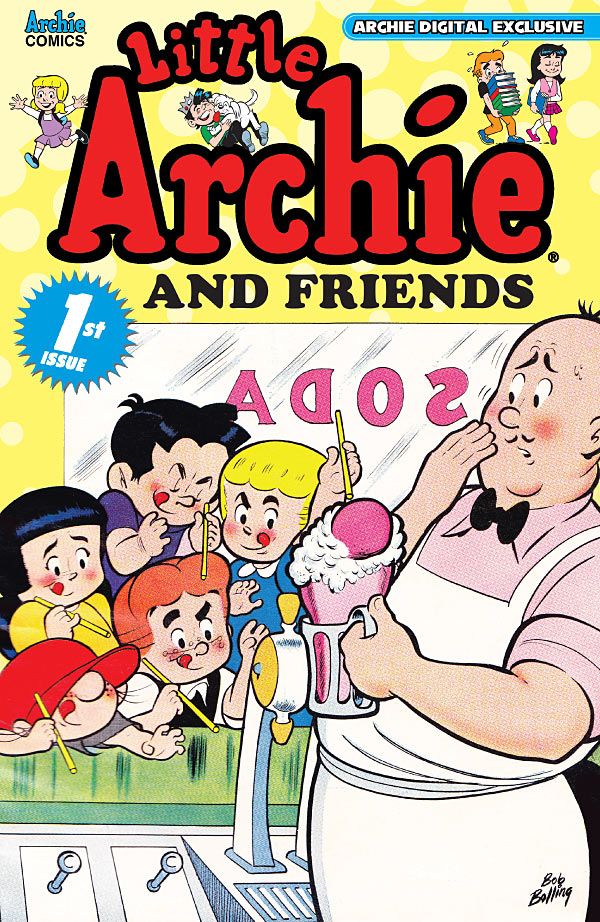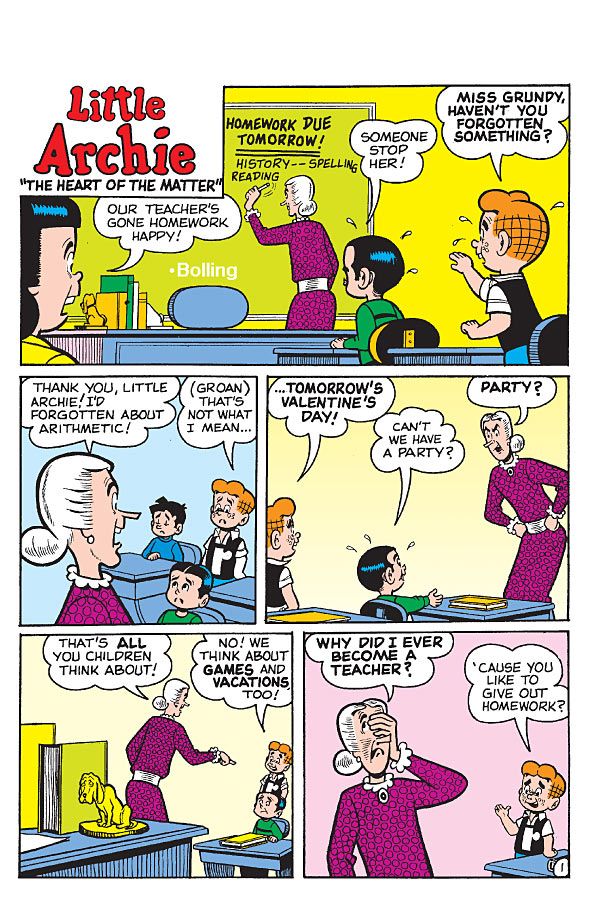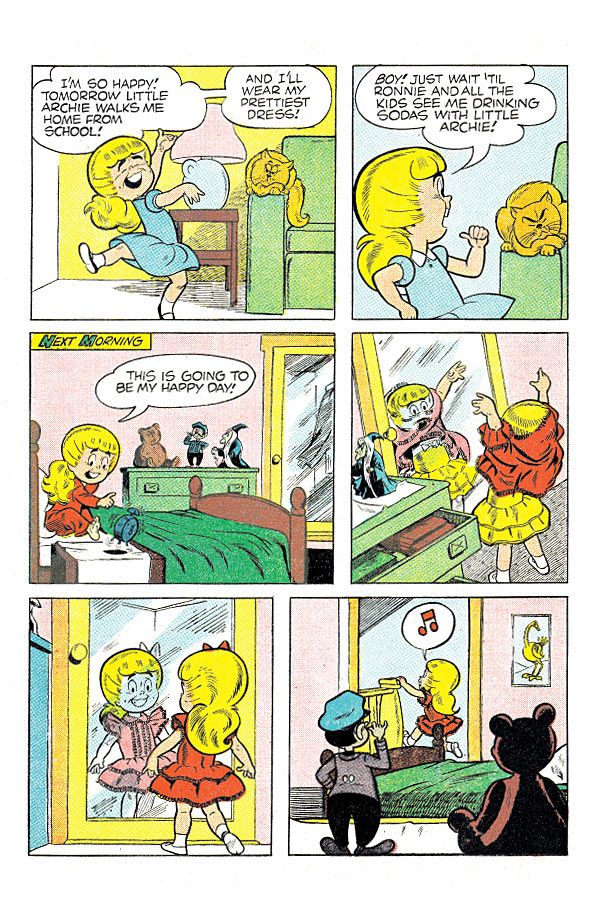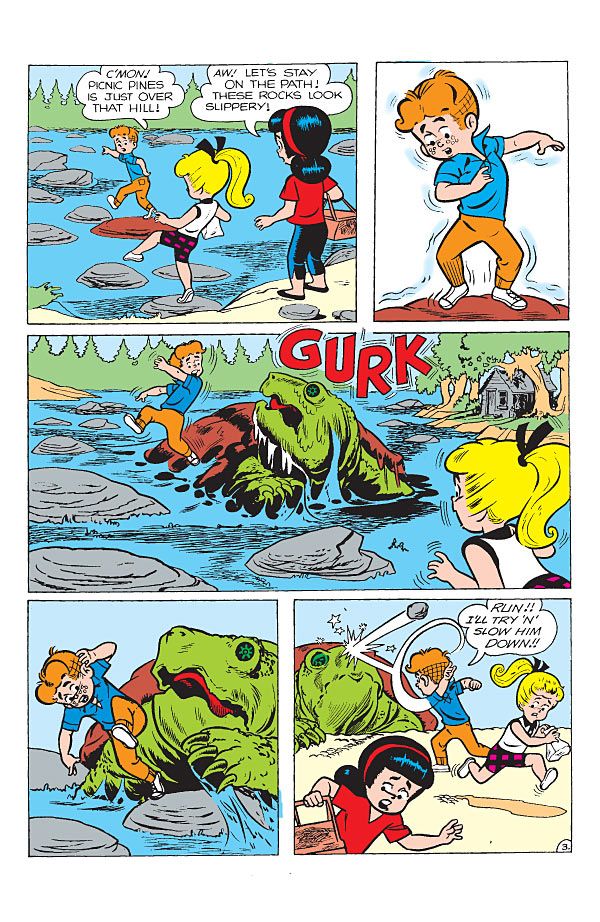Many great artists have worked at Archie Comics, but one of the most talented and beloved cartoonists has to be Bob Bolling. Bolling worked at Archie for decades on a variety of titles, but he is best known for creating "Little Archie" and writing and drawing the series exclusively from 1957-1965. The cartoonist established himself as a master because of the skill with which he moved from slice of life tales to fantastic adventure stories involving aliens, monsters and a mad scientist with plans of world domination named "Mad Doctor Doom."
One of his best known and most loved stories is "The Long Walk," which was included in "The Best of Archie Comics" collection. In the story, three of Betty's dolls narrate a story of how Betty asks Archie to walk her home and he decides to take her on a long, harrowing path that ends with him apologizing to Betty and admiring her bravery. It's a moving and emotional story that never edges into sentimentality, capturing a sense of what it meant to be a child.
Behind the Scenes of Animated "It's Archie" with Jon Goldwater
Bolling has been retired for many years, though he remains an influence on the many cartoonists who have followed him at Archie and across the medium. "Love and Rockets" creators Jaime and Gilbert Hernandez have repeatedly cited him as one of the great cartoonists and a major influence on their work. Archie has announced plans for an animated project, "It's Archie," which features the kids in middle school and draws heavily on Bolling's work and designs. On November 15, Archie is releasing a book-length digital exclusive collection of Bolling's "Little Archie" stories from throughout his career, and he was kind enough to speak with CBR News about his life and work.
CBR: Mr. Bolling, did you always want to be a cartoonist?
Bob Bolling: Yes, I always wanted to be a cartoonist. When I was very young,I loved the "Katzenjammer Kids," then "Blondie" and Zatara the Magician.
What about "Zatara the Magician" appealed to you? I've heard from many others over the years that they were fans of that comic.
"Zatara the Magician's" style was appealing to my immature eyes and the plots suited my immature mind.They still do.
You worked as an assistant to George Shedd who was working on a daily adventure strip, "Marlin Keel." What was that like and what did you learn from him and from working on the strip?
Working on "Marlin Keel" was an enormous help. I learned about writing -- comedy and adventure are quite similar -- design, composition and drawing.
In what way do you think that comedy and adventure are similar?
Comedy or adventure you have a story to tell. They're similar as you write about character in an unfolding series of events. If it's comedy, these events should be funny and surprising.
How did you first start working at Archie?
Doing half-page gags, slowly getting the feel of the Archie image.
Could you talk a little about how you came to create "Little Archie?" You had a really challenging task of talking Bob Montana's designs and really making them instantly recognizable, but always making them your own.
At that time, "Dennis the Menace" was a huge success and all of the Archie artists were wondering why we didn't come up with a similar character.So the editor then asked me to create "Little Archie."
How much oversight or editorial guidance was there when you were making Little Archie? I ask because you were writing and drawing, inking and lettering the stories and creating new characters.
They gave me leeway and I had occasional help from the editor, Harry Shorten, creator of "There Oughta Be a Law."
You mentioned that you had leeway with the strip.Was there any concern over the fact that some of your stories were fantastic or they were adventure tales and different from the typical Archie stories?
I don't know how different my work was. I just didn't want to keep writing the same type of story.
Where did the character of Mad Doctor Doom come from?
It came from me realizing that many similar characters had made their mark in comic book history.
Did you have a model for what you were trying to do or something you were trying to emulate in the Little Archie stories?
No, I just thought of my childhood.I'm still a kid. That helps.
I wanted to ask you about two stories -- and I know it was more than fifty years ago when you created them, but "The Long Walk" and "Caramel Has a Tale" are two of the best known and perhaps most loved comics you made. Do you remember what it was like working on them and do you have any idea why they connected with readers?
I recall "The Long Walk" even though [it was] done so long ago. The simplicity of it made it difficult to write -- wanting to show emotion and visual interest.When you write from the heart it's bound to connect with a lot of readers.
Could you talk a little about Dexter Taylor? I heard that the two of you were roommates before you were working on "Little Archie" together? Did the two of you work together closely during your time on the book?
Yes, Dexter and I were roommates and did work closely together. I roomed with him when I first came to New York.Working closely together enabled us to promote story variety.
You and Dexter Taylor were mostly making "Little Archie" just the two of you for many years. Were you thinking about, 'there needs to be a comedic story, a more emotional story, an adventure story' -- that each issue has to have a range of different stories?
We tried to keep each issue of Little Archie with a range of story types, i.e. simple every day problems to high adventure, all the while trying to be humorous.
Back then you were signing your work and your photograph appeared in some of the books. This was unique at the time for Archie and I'm just wondering how that happened? Were you conscious of how rare this was at the time?
The editor liked my work but was afraid of losing me. I was always talking about going home and going fishing.
Back then, did the artists and writers at Archie know each other and spend time together?
Yes, we all knew each other -- most of us.When we brought our work in on Friday, many of us would have lunch together.
The idea of you and HarryLucey andSamm Schwartz and Dexter Taylor all having lunch together is something many fans would love to sit in on. What would you talk about at these lunches?
Our Friday lunches were helpful to me as I would learn what the other artists liked or didn't like.It helped form my thinking.
Starting in the late '60s you were moved off of "Little Archie" and onto other Archie titles. I know you were drawing a lot and working from other people's scripts, especially Frank Doyle. Did you prefer to draw your own stories?
Both, really.It's relaxing to do someone else's script as no changes were allowed.On my own writing I make changes.
In the 1980s you worked on "Little Archie," "Archie and Me" and "Sabrina," and did some really interesting work that was very different. Your "Sabrina" in particular was different from anything with the character before. Did you approach those stories the same way you had in the '50s and '60s? Were you trying to do something different?
I really can't recall my '80s story approach. I just tried to be different and interesting.
Do you miss making comics?
Sure, once in a while. Comics were a part of me for so long.Whenever an idea would strike me, I would write it down immediately as they can be fleeting.But that doesn't occur now.
When you hear cartoonists today who talk about the stories you created and how they had an affect on them -- Jaime and Gilbert Hernandez have both said that you're one of the beststorytellers in comics they know -- is that flattering, or are you confused by that? How do you react to praise like that?
I'm so flattered by peer praise. If they were here now, I'd buy them all a drink.But they'd have to leave the tip!
Archie's digital "Little Archie" collection featuring work by Bob Bolling goes on sale November 15.







